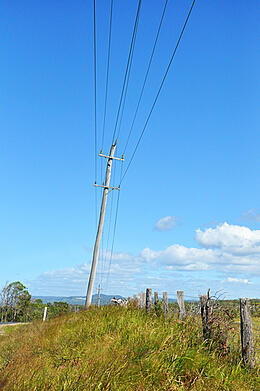Responding to Hazardous Utility Pole Complaints
 Storms are often the cause of damage to utility poles and power lines. When large storm systems, such as hurricanes, come through an area, there is always the potential for utility poles to fail causing widespread power outages to occur, in which case utility pole owners respond immediately to replace poles and restore power. Storms that do not cause poles to break and power to go out can still cause serious damage, but without a downed pole needing to be replaced and power needing to be restored these potentially hazardous damaged poles can be overlooked. This is what happened in Mystic, CT.
Storms are often the cause of damage to utility poles and power lines. When large storm systems, such as hurricanes, come through an area, there is always the potential for utility poles to fail causing widespread power outages to occur, in which case utility pole owners respond immediately to replace poles and restore power. Storms that do not cause poles to break and power to go out can still cause serious damage, but without a downed pole needing to be replaced and power needing to be restored these potentially hazardous damaged poles can be overlooked. This is what happened in Mystic, CT.
During major storms, water from the Mystic River goes over a causeway and that water and the storms appear to be taking a toll on a particular utility pole. One resident of Mystic, claimed, “with each storm the pole seems to lean more and more toward the road. The wires also hang a little bit lower than they used to.”1 While routine utility pole inspections generally would have uncovered this problem pole, and even taken note of the environmental hazards of the body of the water, the next best line of defense the utility pole owner had in this case was this customer. The customer stated that she contacted the pole owner regarding the pole and her concern for the public safety of the community and they asserted it was safe. That is when the local news station decided to get involved. The station received an e-mail response from the pole owner stating they would, in fact, be working to replace the pole as soon as possible.
It is not unusual for local media to get involved in situations such as this in order to support the community and local viewers. If companies respond to customer complaints in the same way they do the media, however, then it can be assumed they would avoid the media ever getting involved in the first place.
The importance of good customer service goes beyond merely avoiding negative press. The following statistics (aggregated on Business Insider2) reinforce just how important customer experience can be to a company and its bottom line:
-
86 percent of consumers quit doing business with a company because of a bad customer experience.
-
Even in a negative economy, customer experience is a high priority for consumers. 60 percent say they often or always pay more for a better experience.
-
About 13 percent of dissatisfied customers tell more than 20 people.
In the midst of the social networking era, providing a positive customer experience and appropriately responding to customer complaints is even more crucial. Imagine if this person had decided to post about her experience regarding the damaged utility pole on Facebook saying that the pole owner only cared about the situation once the media got involved (which is not believed to be the case here at all.) If we consider the fact that the average Facebook user in America has 245 friends on the network 3, then we can start to imagine just how damaging to a company’s reputation a negative customer experience can become.
[1] http://www.wtnh.com/news/new-london-cty/utility-pole-a-safety-hazard-for-mystic
[2] http://www.businessinsider.com/6-customer-experience-statistics--and-the-performance-implications-for-your-business-2011-1
[3] http://www.thewire.com/technology/2013/02/real-friends-vs-facebook-friends/62310/

Comments